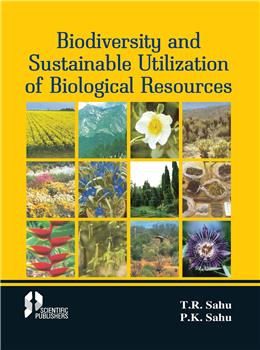
| Select | Format | USD( ) |
|---|---|---|
| Print Book | 37.00 29.60 20%Off | |
| Individual E Book | Buy Now | |
| Institutional E Book | Price available on request |
The book entitled ``Biodiversity Conservation and Sustainable Utilization of Biological Resource is a result of National Conference on sustainable Utilization of Biological Resources held during 16-18 March, 2001, at Department of Botany, Dr. Harisingh Gour Vishwavidayalaya, Sagar (M.P.) India. Biological diversity is the result of interaction between climate, organisms, topography, parent soil materials, time and heredity. The tropics are the ideal places for such an interaction. Indian region having a geographical area of 339 million hectares, is quite rich in biodiversity with a sizeable percentage of endemic flora and fauna. This richness in biodiversity is due to immense variety of climate and altitudinal conditions coupled with varied ecological habitats. He from the humid tropical Western Ghat to the hot deserts of Rajasthan, from the cold desert of Ladak and the icy mountain of Himalayas to the worm coast of peninsular India. The country is very important Vavilovian center of biodiversity and origin of over 167 important cultivated plant species and some domesticated animals. The present books contains articles by eminent scientists of the country on different aspects related to the subject. It contains up-to-date information about the application of biotechnology to meet the ever increasing demand of food, medicine, crop plants and management of environments. The articles related to Botanic Gardens aims to help quantify the global strategy for plant conservation (GSPC) adopted by the convention of Biological Diversity (CBD) in 2002. This will help to reaffirm the commitment of Botanic Gardens to plant conservation, education awareness, implementation of the International Agenda for Botanic Gardens in conservation and the promotion of sustainable development and sustainable living. Scholars and students of Botany, Ethnobotany, Agriculture, Forestry, Conservation, Ecology and Environment will find this book very useful and informative.
1.Spectrum of Biodiversity in the Orissa Mangroves, their Sustainable Exploitation and Germplasm Conservation.
2. Biodiversity Scenario of Western Ghats with particular reference to Uttara Kannada District of Karnataka.
3. Diversity of Grass Flora in India.
4. Value and Exploitation of Indigenous Knowledge related to Biodiversity.
5. Biodiversity at Global and India level with a particular emphasis to Pachmari Biosphere Reserve of M.P. (India)
6. Taxonomy and Conservation of Indian Medicinal Plants.
7. Ecological and Biological Diversity of the Floral Element in the proposed Amarkantak Biosphere Reserve India.
8. Propagation Techniques for Medicinal Plants used in common ailments.
9. Role of NBRI Botanic Garden towards Conservation, Education and Sustainable Utilization of Plant Diversity.
10. Medicinal Plants used in treatment of Indigestion in Raigarh District of Chhattishgarh.
11. Present Status of Higher Plant Diversity of Ralamandal Sanctuary, Indore.
12. Afforestation of Coastal Mangrove Vegetation – Need for Selection of Species and Sustenance of Bio-Diversity
13. Study of Systme Transfer Function of a Grassland Community.
14. Utility of Training Programme in Commercial Cultivation and Awareness of Medicinal and Aromatic Plants.
15. Mangroves of Mahanadi Delta – Past, Present and Prospects for Future.
16. Impact of Pollution on Fruits and Seeds of some Road Side Trees – A Case Study for Bio-Diversity.
17. Genetic Variability in Wheat (Triticum aestivum L.).
18. Floristic Diversity of Haryana – An assessment of Threatened Plants for Conservation.
19. Woody Legumes of Ratlam District M.P.
20. Contributions of University Botanic Gardens to the implementation of the Convention on Biodiversity.
21. Diversity in natural occurrence of Wheat Diseases of Sagar Region.
22. Crop Modelling to sustain better crop harvest out of fluctuating Climate Conditions of Sagar Region of Madhya Pradesh.
23. Mycorrhiza in Sustainable Agriculture.
24. Effect of different sources of Nutrients on growth of Pomegranate (Punica granatum L.)
25. Grain yield and chemical properties of soil as affected by Soyabeen (Glycine max) Genotypes and Fertility Levels.
26. Medicinal utility of Botanic Garden’s Weeds : A Case Study of Sagar University Botanic Garden.
27. Biodiversity Conservation : Different Approaches.
28. Traditional practices in Bastar cause threat to Biodiversity Conservation.
29. Role of University Botanic Gardens in context to BGCI, CBD : A Case Study of Botanic Garden of Dr. Hari Singh Gour University, Sagar.
30. Strategies for sustainable utilization of Biological Resource in the Noradehi Wild Life Sanctuary of Sagar (Madhya Pradesh).

SCIENTIFIC PUBLISHERS
"Granthlok"
5-A,New Pali Road,
Bhagat Ki Kothi (Nr. Police Station)
P. O. Box 91, Jodhpur - 342001 (Rajasthan), INDIA
Mob. :+91-9929272222 +91-9799991782
Tel. :+91-2912433323
Email. info@scientificpub.com
Web. www.scientificpubonline.com
DELHI BRANCH
"Granthlok"
4806/24, Ansari Road,
Bharat Ram Road,
Darya Ganj
New Delhi 110002
INDIA
Mob. : +91-95211 31111
Tel. +91-11-47590696
Email. scientificpubdelhi@gmail.com
Make sure you dont miss interesting happenings
by joining our newsletter program

Government e Marketplace (GeM) is a 100 percent Government owned & National Public Procurement Portal.GeM is dedicated e market for different goods.

© 2024 SCIENTIFIC PUBLISHERS | All rights reserved.